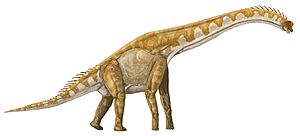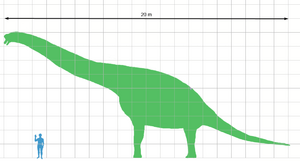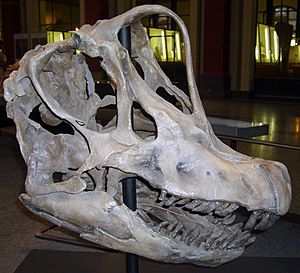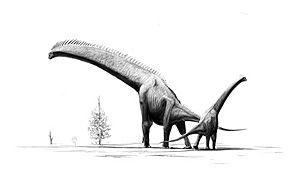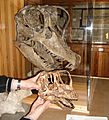Giraffatitan facts for kids
Quick facts for kids GiraffatitanTemporal range: Upper Jurassic
150–145 mya |
|
|---|---|
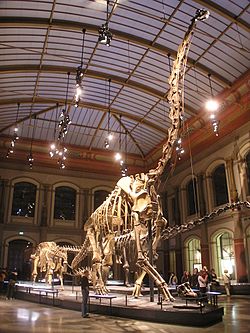 |
|
| Skeleton on display in the Museum für Naturkunde Berlin, Germany | |
| Scientific classification | |
| Kingdom: | |
| Class: | |
| Superorder: | |
| Order: | |
| Infraorder: | |
| Family: | |
| Genus: |
†Giraffatitan
|
Giraffatitan (say "Jih-raff-uh-TY-tan") means "giraffe titan." It was a type of sauropod dinosaur that lived during the Upper Jurassic period, about 140 to 150 million years ago. This giant dinosaur was related to Brachiosaurus and was one of the biggest animals ever to walk on Earth.
Giraffatitan was about 23 meters (75 feet) long and weighed around 40 tons (88,000 pounds). It had a very long neck, which helped it reach and eat tall conifer trees. These trees were common in the Jurassic forests. Giraffatitan lived in the area that is now Tanzania, Africa.
This dinosaur was first named Brachiosaurus brancai in 1914. But in 1991, a scientist named George Olshevsky noticed enough differences to give it its own name, Giraffatitan.
Contents
What Did Giraffatitan Look Like?
Giraffatitan was a sauropod, which means it was a four-legged, plant-eating dinosaur. Like other sauropods, it had a long neck, a long tail, and a fairly small brain. Its body shape was like a giraffe's, with longer front legs than back legs and a super long neck.
Its skull had a tall arch above its eyes. This arch was made of bone and included its nostrils and other openings. Giraffatitan had "spatulate" teeth, which means they were shaped like chisels. These teeth were good for biting off plants. On its front feet, the first toe had a claw. On its back feet, the first three toes also had claws.
Where Were Its Nostrils?
For a long time, scientists debated where Giraffatitans nostrils were. Some thought they were on top of its head. However, studies comparing dinosaur nostrils to modern animals show that nostrils are usually at the front of the snout. This means Giraffatitans nostrils were likely near its mouth, not on top of its head.
Some people also wondered if Giraffatitan had a trunk, like an elephant. But the way its teeth wore down suggests it bit and tore off plants, rather than using a trunk to pick them. This makes it unlikely that Giraffatitan had a trunk.
How Big Was Giraffatitan?
For many years, Giraffatitan was thought to be the biggest dinosaur known. However, in recent times, some other giant dinosaurs called titanosaurs have been found that might have been even heavier. Still, Giraffatitan and Brachiosaurus are among the largest dinosaurs we know from almost complete skeletons.
Most size estimates for Giraffatitan come from a skeleton called HMN SII. This was a young adult dinosaur, about 21.8 to 22.5 meters (71 to 74 feet) long and about 12 meters (39 feet) tall. Figuring out its exact weight is tricky. Scientists estimate it weighed between 23.3 and 39.5 tons (51,000 to 87,000 pounds). These estimates consider that sauropods had air sacs inside their bodies, which made them lighter.
Discovery and Classification
The first Giraffatitan brancai was named and described by a German scientist named Werner Janensch in 1914. He found several dinosaur bones between 1909 and 1912 in the Tendaguru area, near Lindi in what is now Tanzania. Scientists have found five partial skeletons, including three skulls, and many other bone pieces. Giraffatitan lived from about 145 to 150 million years ago, during the Kimmeridgian and Tithonian ages of the Late Jurassic period.
A very famous Giraffatitan brancai skeleton is on display in the Berlin's Natural History Museum. It is one of the largest and tallest mounted skeletons in the world! Werner Janensch found many Giraffatitan bones in Tanzania, including some almost complete skeletons. He used these to create the amazing skeleton you can see today.
How Giraffatitan Lived
Scientists used to think that Giraffatitan spent most of its time in water, using its high nostrils like a snorkel to breathe. They thought the water would help support its huge body. However, scientists now believe Giraffatitan was a fully land animal. Studies show that the water pressure would have made it hard for the dinosaur to breathe underwater. Also, its feet were not shaped well for swimming. Newer studies suggest that even though the skull openings for the nostrils were high up, the actual nostrils were closer to the tip of its snout.
Brain Size and Intelligence
Giraffatitan's brain was quite small, about 300 cubic centimeters. This is tiny compared to its massive body size. Like other sauropods, it had a larger area in its spinal cord near its hips. Some older ideas called this a "second brain," but it was more likely a glycogen body, which stores energy.
How Giraffatitan Stayed Warm
Scientists have different ideas about how Giraffatitan controlled its body temperature. If it was endothermic (warm-blooded), it might have taken about ten years to grow to full size. If it was poikilothermic (cold-blooded), it would have needed over 100 years to grow fully.
As a warm-blooded animal, Giraffatitan would have needed a huge amount of energy every day. It probably ate more than 182 kilograms (400 pounds) of food daily! If it was cold-blooded or a gigantotherm (meaning its large size helped it stay warm), it would have needed much less food. The internal organs of these huge sauropods were likely enormous.
Images for kids
-
Authentic Giraffatitan skull (behind), compared to that of the small brachiosaur Europasaurus
-
The feeding range of Giraffatitan (left) and Sauroposeidon
See also
 In Spanish: Giraffatitan brancai para niños
In Spanish: Giraffatitan brancai para niños


